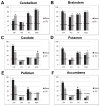Automated, high accuracy classification of Parkinsonian disorders: a pattern recognition approach
- PMID: 23869237
- PMCID: PMC3711905
- DOI: 10.1371/journal.pone.0069237
Automated, high accuracy classification of Parkinsonian disorders: a pattern recognition approach
Abstract
Progressive supranuclear palsy (PSP), multiple system atrophy (MSA) and idiopathic Parkinson's disease (IPD) can be clinically indistinguishable, especially in the early stages, despite distinct patterns of molecular pathology. Structural neuroimaging holds promise for providing objective biomarkers for discriminating these diseases at the single subject level but all studies to date have reported incomplete separation of disease groups. In this study, we employed multi-class pattern recognition to assess the value of anatomical patterns derived from a widely available structural neuroimaging sequence for automated classification of these disorders. To achieve this, 17 patients with PSP, 14 with IPD and 19 with MSA were scanned using structural MRI along with 19 healthy controls (HCs). An advanced probabilistic pattern recognition approach was employed to evaluate the diagnostic value of several pre-defined anatomical patterns for discriminating the disorders, including: (i) a subcortical motor network; (ii) each of its component regions and (iii) the whole brain. All disease groups could be discriminated simultaneously with high accuracy using the subcortical motor network. The region providing the most accurate predictions overall was the midbrain/brainstem, which discriminated all disease groups from one another and from HCs. The subcortical network also produced more accurate predictions than the whole brain and all of its constituent regions. PSP was accurately predicted from the midbrain/brainstem, cerebellum and all basal ganglia compartments; MSA from the midbrain/brainstem and cerebellum and IPD from the midbrain/brainstem only. This study demonstrates that automated analysis of structural MRI can accurately predict diagnosis in individual patients with Parkinsonian disorders, and identifies distinct patterns of regional atrophy particularly useful for this process.
Conflict of interest statement
Figures




References
-
- Litvan I, Bhatia KP, Burn DJ, Goetz CG, Lang AE et al. (2003) SIC Task Force appraisal of clinical diagnostic criteria for Parkinsonian disorders. Mov Disord 18: 467-486. doi:10.1002/mds.10459. PubMed: 12722160. - DOI - PubMed
-
- Hauw JJ, Daniel SE, Dickson D, Horoupian DS, Jellinger K et al. (1994) Preliminary NINDS neuropathologic criteria for Steele-Richardson-Olszewski syndrome (progressive supranuclear palsy). Neurology 44: 2015-2019. doi:10.1212/WNL.44.11.2015. PubMed: 7969952. - DOI - PubMed
-
- Papp MI, Lantos PL (1994) The distribution of oligodendroglial inclusions in multiple system atrophy and its relevance to clinical symptomatology. Brain 117: 235-243. doi:10.1093/brain/117.2.235. PubMed: 8186951. - DOI - PubMed
-
- Braak H, Braak E (2000) Pathoanatomy of Parkinson’s disease. J Neurol 247: 3-10. doi:10.1007/s004150050002. PubMed: 10701890. - DOI - PubMed
-
- Deuschl G, Schade-Brittinger C, Krack P, Volkmann J, Schäfer H et al. (2006) A randomized trial of deep-brain stimulation for Parkinson’s disease. N Engl J Med 355: 896-908. doi:10.1056/NEJMoa060281. PubMed: 16943402. - DOI - PubMed
Publication types
MeSH terms
Grants and funding
LinkOut - more resources
Full Text Sources
Other Literature Sources
Miscellaneous

